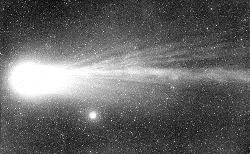
Comets

![]()
The outermost members of the solar system occasionally pay a visit to the inner planets. As
asteroids are the rocky and metallic remnants of the formation of the solar system, comets are the icy debris from that dim beginning and can survive only far from the Sun. Most comet nuclei reside in the Oort Cloud, a loose swarm of objects in a halo beyond the planets and reaching perhaps halfway to the nearest star.Comet nuclei orbit in this frozen abyss until they are gravitationally perturbed into new orbits that carry them close to the Sun. As a nucleus falls inside the orbits of the outer planets, the volatile elements of which it is made gradually warm; by the time the nucleus enters the region of the inner planets, these volatile elements are boiling. The nucleus itself is irregular and only a few miles across, and is made principally of water-ice with methane and ammonia -- materials very similar to those composing the moons of the giant planets.
As these materials boil off the nucleus, they form a coma or cloud-like "head" that can measure tens of thousands of kilometers across. The stream of charged particles coming from the Sun pushes on this cloud, blowing it back like a flag in the wind and giving rise to the comet's "tails." Gases and ions are blown directly back from the nucleus, but dust particles are pushed more slowly. As the nucleus continues in its orbit, the dust particles are left behind in a curved arc.
The tails can reach 150 million kilometers (93 million miles) in length, but the total amount of material contained in this dramatic display would fit in an ordinary suitcase. Comets -- from the Latin cometa, meaning "long-haired" -- are essentially dramatic light shows.
Some comets pass through the solar system only once, but others have their orbits gravitationally modified by a close encounter with one of the giant outer planets. These latter visitors can enter closed elliptical orbits and repeatedly return to the inner solar system.
Halley's Comet is the most famous example of a relatively short period comet, returning on an average of once every 76 years and orbiting from beyond Neptune to within Venus' orbit. Confirmed sightings of the comet go back to 240 B.C. This regular visitor to our solar system is named for Sir Edmund Halley, because he plotted the comet's orbit and predicted its return, based on earlier sightings and Newtonian laws of motion. His name became part of astronomical lore when, in 1759, the comet returned on schedule. Unfortunately, Sir Edmund did not live to see it.
A comet can be very prominent in the sky if it passes comparatively close to Earth. Unfortunately, on its most recent appearance, Halley's Comet passed no closer than 62.4 million kilometers (38.8 million miles) from our world. The comet was visible to the naked eye, especially for viewers in the southern hemisphere, but it was not spectacular. Comets have been so bright, on rare occasions, that they were visible during daytime. Historically, comet sightings have been interpreted as bad omens and have been artistically rendered as daggers in the sky.
The Comet Rendezvous/Asteroid Flyby (CRAF) spacecraft will become the first traveler to fly close to a comet nucleus and remain in proximity to it as they both approach the sun. CRAF will observe the nucleus as it becomes active in the growing sunlight and begins to have its lighter elements boil off and form a coma and tails. Several spacecraft have flown by comets at high speed; the first was NASA's International Cometary Explorer in 1985. An armada of five spacecraft (two Japanese, two Soviet and the Giotto spacecraft from the European Space Agency) flew by Halley's Comet in 1986.
![]()